SCULPTOR
Karl Alfred Quilter
Studied At/With
University of Utah;
Salt Lake Art Center, Utah;
Avard Fairbanks, Utah
Born
27 April 1929
Died
27 November 2013
“The Book of Mormon is full of very powerful individuals influenced by the Lord. How fitting that one of the most faithful and dynamic of these was Moroni, who would carry their story to our generations. The Angel Moroni should be portrayed as a powerful masculine figure.”
–Karl Quilter
Birth and Early Life
Karl Quilter was born in Castle Gate, Utah to Alfred Powell Quilter and Vera Hales Quilter. Karl’s Father, Alfred, was born in Yorkshire England and immigrated to the United States with his parents as a youth. Karl’s Mother was Born in Utah, and married Alfred in 1926.[1]“Karl Alfred Quilter.” FamilySearch, The Church of Jesus Christ of Latter-Day Saints.
When Karl was young, his parents moved the family to Henryville, near Bryce Canyon, Utah. Growing up in Henryville, Karl would often play on banks of local irrigation ditches making animals out of clay.[2]Biographical interview With Karl Quilter, 18 March 1992, by Fred Roe, via: Roe, Frederick Robert 1920-. Angels: Moroni and his associates / Fred Roe [Bountiful, Utah]: The Author, 1992 May 1992 printing, p 49. (accessed: 5 September 5 2018) One of the grade school teachers noticed the natural artistic ability of both Karl and his brother, and encouraged the family to get them a better opportunity for training.[3]Biographical interview With Karl Quilter, 18 March 1992, by Fred Roe, via: Roe, Frederick Robert 1920-. Angels: Moroni and his associates / Fred Roe [Bountiful, Utah]: The Author, 1992 May 1992 printing, p 49. (accessed: 5 September 5 2018) Karl was able to attend High School in south Salt Lake High School. Karl’s teacher encouraged him to take up oil painting. One day, Karl began working with some clay in the classroom. Initially the teacher tried to discourage him from working with the clay, and to stick with painting.[4]Biographical interview With Karl Quilter, 18 March 1992, by Fred Roe, via: Roe, Frederick Robert 1920-. Angels: Moroni and his associates / Fred Roe [Bountiful, Utah]: The Author, 1992 May 1992 printing, p 49. (accessed: 5 September 5 2018)
“Karl, don’t ever paint again,” his teacher told him after seeing what the young artist could do.“Sculptor’s Works Top Temple Towers Worldwide.” Ensign, The Church of Jesus Christ of Latter-Day Saints, Apr. 2006.
Latter-day Saint Mission
Karl was called to serve in the Northern States Mission,[5]Deseret News. “Obituary: QUILTER, KARL.” Deseret News, Deseret News, 1 Dec. 2013. where he created his first non-commissioned sculpture,[6]Stecklein, Janelle. “Utah Sculptor of Mormon Angel Moroni Statues Dies at 84.” The Salt Lake Tribune, The Salt Lake Tribune, 13 Dec. 2013. a papier mâché statue at a state fair booth.[7]Rosner, Jannalee. “‘Super Moroni’ Statue Almost Appeared on Nauvoo Temple, Sculptor’s Son Recalls.” LDS Living, 27 Oct. 2016. More than 250,000 people viewed his first statue, standing about 2 feet.[8]Stecklein, Janelle. “Utah Sculptor of Mormon Angel Moroni Statues Dies at 84.” The Salt Lake Tribune, The Salt Lake Tribune, 13 Dec. 2013. The statue, a standing figure holding gold plates in the crook of a bent left arm with the right hand raised high, as if beckoning or greeting someone,[9]“Karl A. Quilter’s First Angel Moroni.” Karl A. Quilter Karl A. Quilter’s First Angel Moroni – FamilySearch.org, Mcq, 16 Feb. 2014, was used in booths set up at the Ohio and Indiana state fairs.[10]Stecklein, Janelle. “Utah Sculptor of Mormon Angel Moroni Statues Dies at 84.” The Salt Lake Tribune, The Salt Lake Tribune, 13 Dec. 2013.
Karl’s son would later relate an experience where, due to this statue, he was approached by one of the prophets, who told him, “Karl, I want you to pursue this sculpturing and keep with it because one day you’re going to make a great contribution to the Church.”[11]Rosner, Jannalee. “‘Super Moroni’ Statue Almost Appeared on Nauvoo Temple, Sculptor’s Son Recalls.” LDS Living, 27 Oct. 2016.
Education
Sculpture at the U of U
Upon returning home, Karl Quilter attended the University of Utah with a scholarship in sculpture.[12]Biographical interview With Karl Quilter, 18 March 1992, by Fred Roe, via: Roe, Frederick Robert 1920-. Angels: Moroni and his associates / Fred Roe [Bountiful, Utah]: The Author, 1992 May 1992 printing, p 49. (accessed: 5 September 5 2018) While working on his degree in Sculpture he had the opportunity to be mentored by Avard Fairbanks.[13]Biographical interview With Karl Quilter, 18 March 1992, by Fred Roe, via: Roe, Frederick Robert 1920-. Angels: Moroni and his associates / Fred Roe [Bountiful, Utah]: The Author, 1992 May 1992 printing, p 49. (accessed: 5 September 5 2018) (This would have been in the early 1950’s prior to Avard being chosen to sculpt the Angel Moroni Statue for the Washington D. C. Temple.) Karl was found to be very talented student, and after the first year was moved to an advanced class, where he was able to assist in instruction for other classes.[14]Biographical interview With Karl Quilter, 18 March 1992, by Fred Roe, via: Roe, Frederick Robert 1920-. Angels: Moroni and his associates / Fred Roe [Bountiful, Utah]: The Author, 1992 May 1992 printing, p 49. (accessed: 5 September 5 2018) Near the end of his schooling, a fellow student asked Karl what he would like to do in life. Even then, Brother Quilter knew, he told his classmate that someday he wanted to sculpt an Angel Moroni statue for a temple.[15]Biographical interview With Karl Quilter, 18 March 1992, by Fred Roe, via: Roe, Frederick Robert 1920-. Angels: Moroni and his associates / Fred Roe [Bountiful, Utah]: The Author, 1992 May 1992 printing, p 49. (accessed: 5 September 5 2018)
Industrial Design at the U of U
Quilter earned a second degree while at the University of Utah. He studied Industrial Design, a study that introduced him to new materials. While there he began his experiments with casting statues in Fiberglass.[16]Stecklein, Janelle. “Utah Sculptor of Mormon Angel Moroni Statues Dies at 84.” The Salt Lake Tribune, The Salt Lake Tribune, 13 Dec. 2013.
Educator
Brother Quilter would go on to further his education at Brigham Young.[17]“Sculptor’s Works Top Temple Towers Worldwide.” Presumably this was so that he could start his career as a Seminary Teacher.
You may have noticed at this point that pretty much all the Sculptors who have worked on Angle statues had other jobs as well as sculpting. In most cases, this was teaching. In the case of Karl Quilter, he chose to teach the religion that he loved and grew up with. Brother Quilter, known to his later students as ‘the notorious “B.Q.,”’[18]“Obituary: QUILTER, KARL.” taught Seminary for many years at Highland High School, West High School, and Olympus High School.[19]“LDS Sculptor Leaves Lasting Legacy.” Church News and Events, The Church of Jesus Christ of Latter-Day Saints, 5 Dec. 2013.
Work for the Church
Bern Switzerland, London England, and Hamilton New Zealand
Round about 1954, Millard Malin invited Karl to come and assist him,[20]Biographical interview With Karl Quilter, 18 March 1992, by Fred Roe, via: Roe, Frederick Robert 1920-. Angels: Moroni and his associates / Fred Roe [Bountiful, Utah]: The Author, 1992 May 1992 printing, p 49. (accessed: 5 September 5 2018) along with a few others, in sculpting some oxen for the Bern Switzerland Temple. Karl was in his early twenties at the time. The job took several months, and once completed, casts of these new oxen were created for the Bern Switzerland, London England, and Hamilton New Zealand Temples.[21]Sculptor’s Works Top Temple Towers Worldwide. The first-time multiple copies of a single set of oxen had been used at multiple temples. This predates the first-time multiple copies of Angel statues were used as well.
Brother Quilter and LaVar Wallgren had already been doing some work together when the Church contacted Brother Quilter about doing an Angel Moroni Statue.
Angel Moroni
When designs for smaller temples started to emerge, they were initially spire less, lacking any statue at all. When the designs were revised, a new, lighter-weight Moroni became necessary.[22]Rosner, Jannalee. “‘Super Moroni’ Statue Almost Appeared on Nauvoo Temple, Sculptor’s Son Recalls.” LDS Living, 27 Oct. 2016. The narrow spires of the new temple designs could not support the massive statues that came before, weighing between 3/4 to 2-1/2 tons each. Quilter would eventually sculpt 3 separate designs for the Church, but his first statue, standing at about 7 feet heal to head, and weighing about 260 pounds[23]Stecklein, Janelle. “Utah Sculptor of Mormon Angel Moroni Statues Dies at 84.” The Salt Lake Tribune, The Salt Lake Tribune, 13 Dec. 2013. could be put anywhere in comparison to their predecessors.
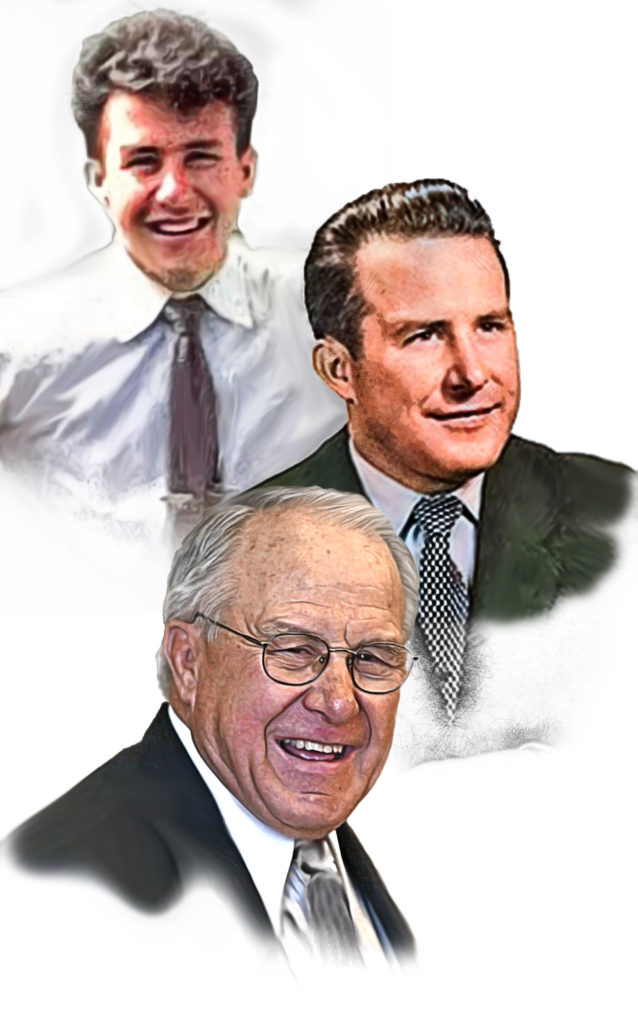
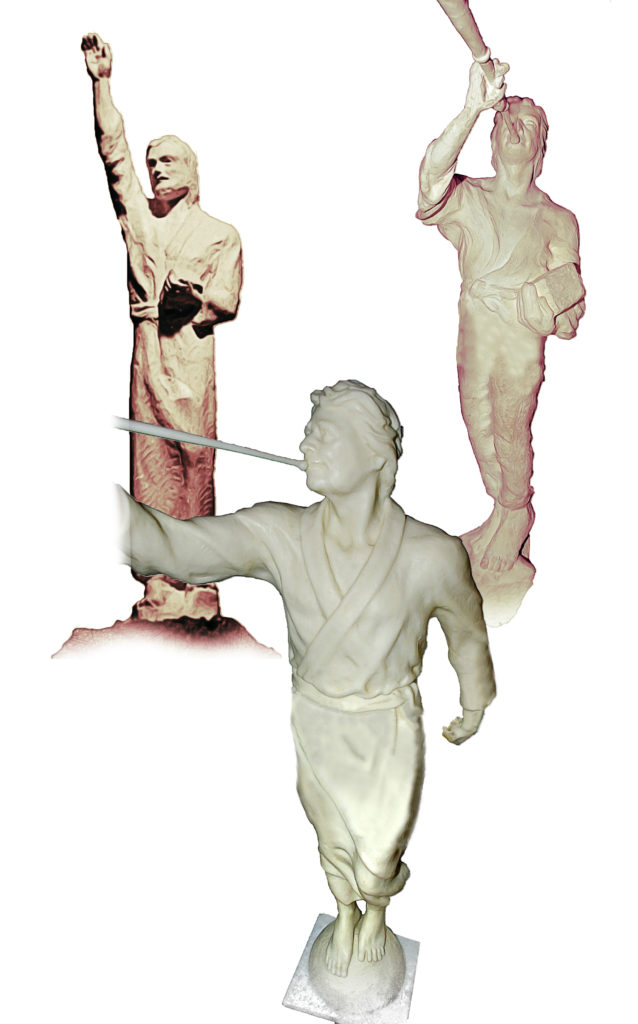
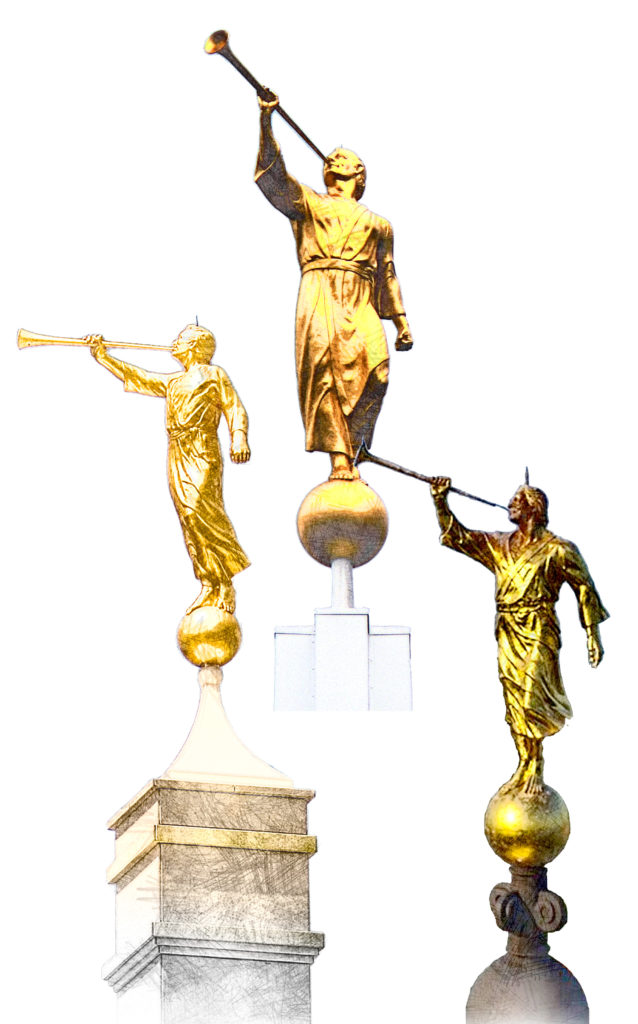
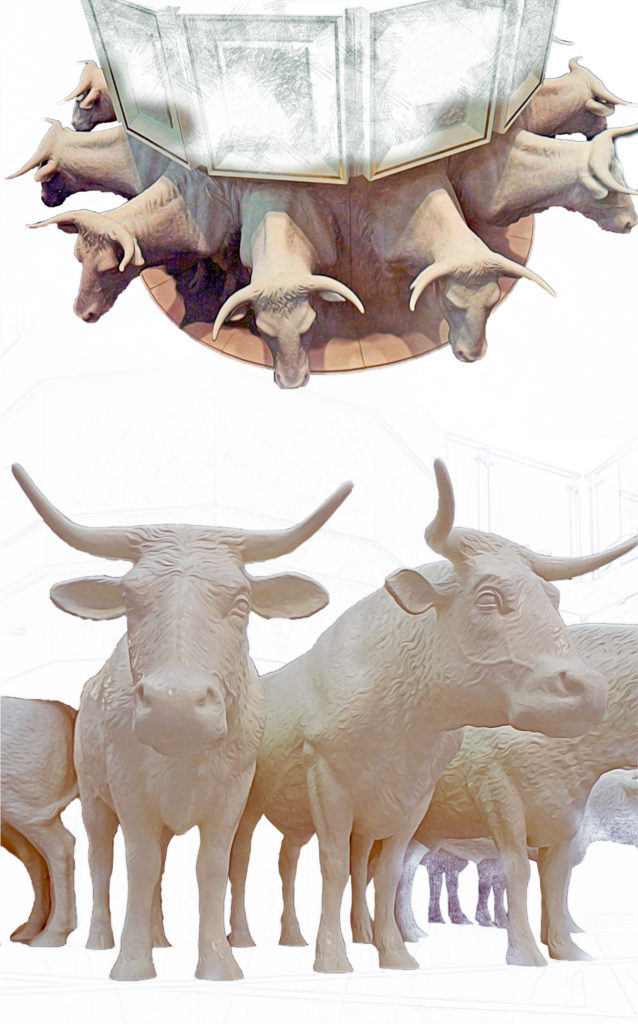
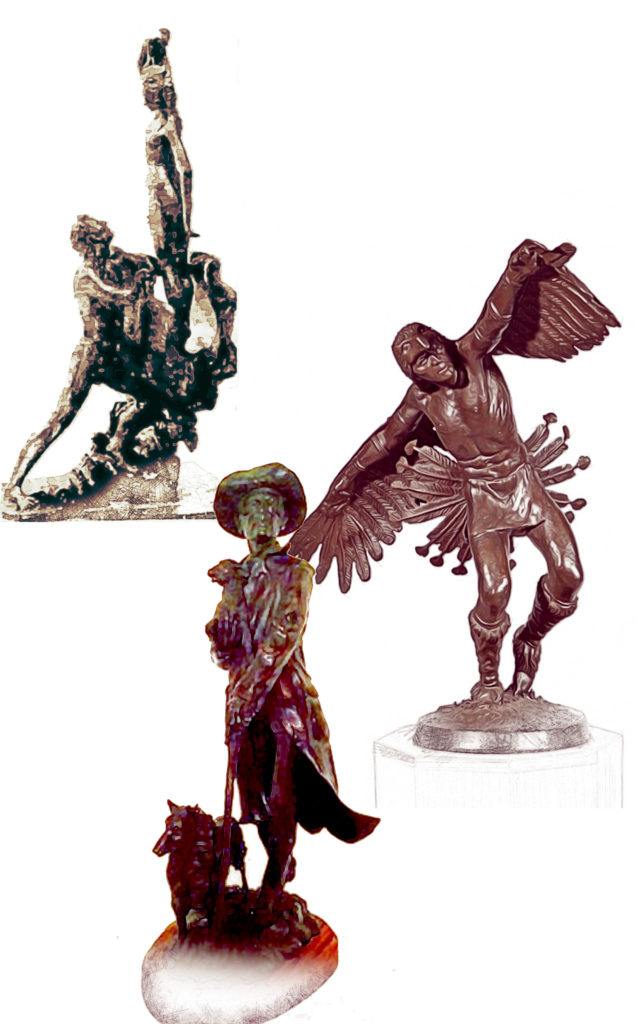
Karl Quilter’s statues were lighter, easier to transport to locations around the globe, cost less to make, and could be lifted into place by smaller cranes or even helicopters. Additionally, they did not require the heavy structural reinforcement earlier statues required due to being cast from metals, allowing temples to be built to different building codes and still retain a statue.[24]“Sculptor’s Works Top Temple Towers Worldwide.” This allowed for statues to be placed on smaller temples and narrower spires, including temples that had not been originally designed to have the statue.
Another larger statue was created by him in the late 1980’s, and eventually a third, mid-sized Angel Moroni was crafted in the late 1990’s. All told, there are only 13 Angel Moroni Statues on Temples, out of almost 160, which are not replicas of one of Quilter’s three designs.
Quilter’s three statues are often mistaken for one statue, or at best, three different sizes of one statue. But each statue is different with a unique pose.
Oxen
As the Church rolled out plans for smaller temples using standardized floorplans in the 1980’s the need arose to mass produce not only Angel Statues, but Oxen statues for the temple baptisteries. These too were created by Karl Quilter and cast in fiberglass with the help of Wallgren.[25]Ostler, Shannon W. “How Moroni Statues Are Made.” The Friend, The Church of Jesus Christ of Latter-Day Saints.
Karl’s first set of Oxen pictured in a Church News article from 1983,[26]Hart, John L. “Statues Sculpted in Fiberglass.” Deseret News, 4 Sept. 1983, pp. 8–13. are a re-sculpting of precast concrete oxen created for temples built in the 1970’s. Karl’s version used the same posing of the oxen, but more stylistic reeds behind the oxen, and less pronounced hair. Karl’s fiberglass oxen were used on the single story, six spired, sloped roof temples built in the 1980’s.[27]This observation was made by comparing photos released by the church showing the font and oxen of multiple temples. Duplicate sets of Oxen were made out of precast concrete in the 1970’s for Ogden Utah, Provo Utah, Washington DC, São Paulo Brazil, Tokyo, Seattle, Jordan River, and Mexico City Temples. Another full-size copy was made for a display in the basement of the North Visitors center at Temple Square. The Visitors Center copy was removed in the early 1990’s, and used on the Vernal Utah Temple font. (Lloyd, R. Scott. “Vernal Temple Doors Open to Public.” Church News, The Church of Jesus Christ of Latter-Day Saints, 18 Oct. 1997.) Visual confirmation of Karl’s initial fiberglass oxen set was made by comparing the Church News article photo to photos of the Baptistries and fonts available for other temples. While photos are not available for all temples, copies of Quilter’s oxen were found in at least the following temples: Boise Idaho, Dallas Texas, Chicago Illinois, Johannesburg South Africa, Seoul Korea, and Denver Colorado. In an interview with Karl Quilter in 2006[28]“Sculptor’s Works Top Temple Towers Worldwide.” it was noted that most temple oxen had been done by Brother Quilter. While the Church has not released a list of which temples he did, an examination of Temple baptistry photos released during his lifetime show four or five distinct sets of oxen being used over and over for all the temples from 1980 through about 2010. It becomes apparent that if not all, the greater majority of all Angel Moroni Statues and Oxen created over a 30+ year period were done by Karl Quilter.
Nativity
Later in life, Quilter would serve another mission for the Church, this time for the Temple Department. The call was to sculpt a nativity scene for the Church that has been replicated and distributed to most temples in the world.[29]Rosner, Jannalee. “‘Super Moroni’ Statue Almost Appeared on Nauvoo Temple, Sculptor’s Son Recalls.” LDS Living, 27 Oct. 2016. This white three-piece nativity set consists of a central Piece depicting Mary, Joseph and the baby Jesus in a family group. The other two pieces of the nativity are a kneeling donkey, and a kneeling pair ewe with her lamb.
Other Work
Karl Quilter did do other pieces besides the work he did for the Church. In 1987, during the centennial celebration for Ricks College (now BYU Idaho) A “heroic size statue” of the schools Viking mascot was placed in the Hart Building on campus. The statue was placed upon a rotating base, and would face the stadium for football games, and the arena for basketball games.[30]Crowder, David L. “THE SPIRIT of RICKS: A HISTORY of RICKS COLLEGE.” Chapter 19, RICKS COLLEGE. Another piece Quilter is known for is that of a modern take on a shepherd, a cowboy hat on his head and a dog at his side, carrying a lost sheep.[31]Rosner, Jannalee. “‘Super Moroni’ Statue Almost Appeared on Nauvoo Temple, Sculptor’s Son Recalls.” LDS Living, 27 Oct. 2016. One of the earliest commercial works Quilter did was a sculpture known as the “The Release of Aphrodite,” a sculpture created for a health Spa in Philadelphia.[32]Dibble, Gregory. “Paper Shortage May Chalk up a Gain for Artist.” The Salt Lake Tribune, 30 Dec. 1973, p. E3.
Brother Quilter also did a commission that stands across the street from the Utah State Capital. The piece is, a bronze statue of a widow and her young son leaving behind the grave of a small daughter, is on the grounds of the Pioneer Museum and was commissioned by the Daughters of Utah Pioneers.[33]“President James E. Faust Dedicates New Monument to Pioneer Women.” Ensign, March 2002.
Famous Works by Karl Quilter
| Angel Moroni Submission Washington D.C. Temple | Church Archives | 1970’s |
| Assembly hall tower cupolas | Salt Lake Temple Square | 1981 |
| Angel Moroni, 7 ft. | 90+ Temples worldwide | 1982 |
| Angel Moroni, 10 ft. | 50+ Temples worldwide | 1985 |
| Angel Moroni 6 ft. 10 in | Nauvoo Illinois, Reno Nevada, Manhattan New York | 1997 |
| 3 pc Nativity | Various Temples worldwide | 2000’s |
Chapter 4 Navigation
Related Articles
← Quilter’s First
← Quilters Second
← Quilter’s Last
References
| ↑1 | “Karl Alfred Quilter.” FamilySearch, The Church of Jesus Christ of Latter-Day Saints. |
|---|---|
| ↑2, ↑12, ↑13, ↑14, ↑15 | Biographical interview With Karl Quilter, 18 March 1992, by Fred Roe, via: Roe, Frederick Robert 1920-. Angels: Moroni and his associates / Fred Roe [Bountiful, Utah]: The Author, 1992 May 1992 printing, p 49. (accessed: 5 September 5 2018) |
| ↑3, ↑4, ↑20 | Biographical interview With Karl Quilter, 18 March 1992, by Fred Roe, via: Roe, Frederick Robert 1920-. Angels: Moroni and his associates / Fred Roe [Bountiful, Utah]: The Author, 1992 May 1992 printing, p 49. (accessed: 5 September 5 2018) |
| ↑5 | Deseret News. “Obituary: QUILTER, KARL.” Deseret News, Deseret News, 1 Dec. 2013. |
| ↑6, ↑8, ↑10, ↑16, ↑23 | Stecklein, Janelle. “Utah Sculptor of Mormon Angel Moroni Statues Dies at 84.” The Salt Lake Tribune, The Salt Lake Tribune, 13 Dec. 2013. |
| ↑7, ↑11, ↑22, ↑29, ↑31 | Rosner, Jannalee. “‘Super Moroni’ Statue Almost Appeared on Nauvoo Temple, Sculptor’s Son Recalls.” LDS Living, 27 Oct. 2016. |
| ↑9 | “Karl A. Quilter’s First Angel Moroni.” Karl A. Quilter Karl A. Quilter’s First Angel Moroni – FamilySearch.org, Mcq, 16 Feb. 2014, |
| ↑17, ↑24, ↑28 | “Sculptor’s Works Top Temple Towers Worldwide.” |
| ↑18 | “Obituary: QUILTER, KARL.” |
| ↑19 | “LDS Sculptor Leaves Lasting Legacy.” Church News and Events, The Church of Jesus Christ of Latter-Day Saints, 5 Dec. 2013. |
| ↑21 | Sculptor’s Works Top Temple Towers Worldwide. |
| ↑25 | Ostler, Shannon W. “How Moroni Statues Are Made.” The Friend, The Church of Jesus Christ of Latter-Day Saints. |
| ↑26 | Hart, John L. “Statues Sculpted in Fiberglass.” Deseret News, 4 Sept. 1983, pp. 8–13. |
| ↑27 | This observation was made by comparing photos released by the church showing the font and oxen of multiple temples. Duplicate sets of Oxen were made out of precast concrete in the 1970’s for Ogden Utah, Provo Utah, Washington DC, São Paulo Brazil, Tokyo, Seattle, Jordan River, and Mexico City Temples. Another full-size copy was made for a display in the basement of the North Visitors center at Temple Square. The Visitors Center copy was removed in the early 1990’s, and used on the Vernal Utah Temple font. (Lloyd, R. Scott. “Vernal Temple Doors Open to Public.” Church News, The Church of Jesus Christ of Latter-Day Saints, 18 Oct. 1997.) Visual confirmation of Karl’s initial fiberglass oxen set was made by comparing the Church News article photo to photos of the Baptistries and fonts available for other temples. While photos are not available for all temples, copies of Quilter’s oxen were found in at least the following temples: Boise Idaho, Dallas Texas, Chicago Illinois, Johannesburg South Africa, Seoul Korea, and Denver Colorado. |
| ↑30 | Crowder, David L. “THE SPIRIT of RICKS: A HISTORY of RICKS COLLEGE.” Chapter 19, RICKS COLLEGE. |
| ↑32 | Dibble, Gregory. “Paper Shortage May Chalk up a Gain for Artist.” The Salt Lake Tribune, 30 Dec. 1973, p. E3. |
| ↑33 | “President James E. Faust Dedicates New Monument to Pioneer Women.” Ensign, March 2002. |
